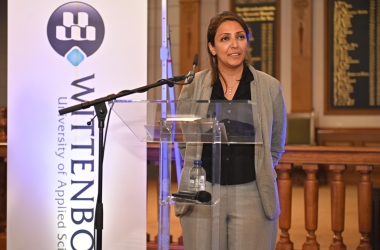Shayesteh Nasabi Wins Best Master’s Thesis Award for Boss Fragrances Case Study

How Packaging Influences Generation Y Women’s Perfume Purchases
What makes a Generation Y woman reach for a perfume on the shelf? Is it the bottle’s shape or the colour of the packaging? These were some of the key questions Wittenborg graduate Shayesteh Nasabi set out to explore in her thesis titled ‘Examining the Impact of Packaging Elements on Purchase Decisions of Female Generation Y Consumers: A Case Study on Boss Fragrances’.
For her thesis, submitted in 2024, Nasabi focused on how visual and verbal packaging elements affect the buying decisions of Generation Y (millennials) women shopping for Boss perfumes in Amsterdam. By closely examining consumer reactions, she revealed which design features truly influence purchases in the premium fragrance market.
Her work stood out for its depth and practical insights, earning her the Best Thesis Award for 2024 during Wittenborg’s recent summer graduation ceremony.
From theory to shelves: how packaging sells
Nasabi, originally from Iran, graduated with a Master of Business Management in Digital Marketing and Communication. Her thesis focused on the role of packaging in the cosmetics industry, particularly how it influences millennial women who are often targeted by luxury fragrance brands.
“Packaging is a critical element of the marketing mix that influences consumer behaviour, especially at the point of sale,” she explained. “In the premium fragrance industry, packaging is often the first interaction consumers have with the product, making it essential for influencing purchasing decisions.”
Her research specifically focused on secondary packaging — the outer box and visual elements surrounding the perfume bottle. She chose Boss as a case study, conducting interviews in three of the brand’s stores in Amsterdam: Bijenkorf, Leidsestraat and P.C. Hooftstraat.
A methodical and consumer-centred approach
To collect meaningful data, Nasabi conducted semi-structured interviews with 20 female Generation Y consumers who had purchased or used Boss women perfumes. All participants were approached in-store between November 2023 and March 2024, with prior consent from store management.
The interviews explored several topics:
- Visual packaging elements: colour, shape, size, typography, material and graphics
- Verbal packaging elements: brand name and product information
- Emotional responses to packaging
- Moderating factors like time pressure, level of involvement and education
- Purchasing habits and brand loyalty
The qualitative data was analysed thematically and supported by a literature review to build a conceptual framework.
Findings: what really sways the buyer?
The study revealed that visual packaging elements had a stronger influence on purchase decisions than verbal ones. Among visual factors, shape was the most impactful — cited by 18 out of 20 participants — followed by colour, cited by 17. These visual cues were associated with perceptions of modernity, uniqueness and innovation, building trust in the Boss brand.
Verbal elements like brand name and product information were less influential overall, but gained importance under time pressure. In situations where consumers had less time to compare options, the brand/model name served as a shortcut for quality and familiarity.
All participants considered Boss perfumes to be high-involvement products, requiring thoughtful decisions — which explains the dominance of visual cues in normal shopping conditions.
Interestingly, educational background also played a role. Those with bachelor’s degrees focused more on visual aspects, while master’s degree holders considered both visual and verbal elements when making their purchasing decisions.
Life after Wittenborg
Nasabi is now working as a Business Development Executive at Van Caem Klerks Group, an international trading house with over fifty years of expertise in the import/export industry.
When asked what she enjoyed most about writing her thesis, she said:
“I really enjoyed conducting qualitative research and speaking directly with consumers — especially analysing their emotional and behavioural responses to packaging. It made the research come alive.”
She also credited her academic supervisor, Wittenborg’s Andreas Ooijer, and Wittenborg’s faculty for their support, as well as the Hugo Boss store teams and her partner for encouraging her through the process.
For current and future Wittenborg students preparing their final research projects, Nasabi offered practical advice:
“Choose a topic you are genuinely interested in and that has real-world relevance. Narrow your scope early to keep your project manageable. Use clear research models, collect data ethically and always connect your findings back to the literature.”
WUP 30/07/2025
by Erene Roux
©WUAS Press